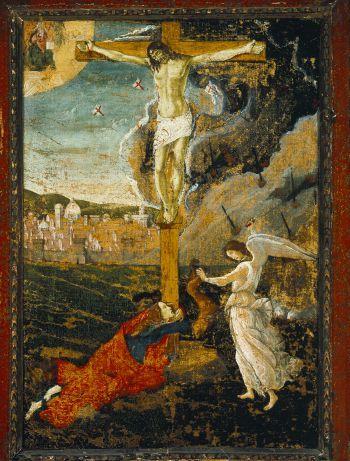Republican-American
April 26, 2008
http://www.rep-am.com/articles/2008/04/26/lifestyle/335734.txt
At the dawn of the 16th century, the Renaissance master Botticelli unveiled a painting known as "The Mystic Crucifixion." It's a creepily evocative image of a slingshot-wielding angel screaming out of the blackened heavens, clutching a tiny lion, ready to set Florence aflame. Well, Florence deserved it, but not nearly as much as Rome, which was then toxic with randy, grasping popes and riven with ecclesiastic dissension.
The angel is said to represent the notorious Girolamo Savonarola (1452-98), of "bonfire of the vanities" fame, a rather sanctimonious Dominican intent on purifying the debauched church. At the foot of the cross, the ever-repentant Mary Magdalene, representing the Catholic Church, clutches the cross, as the wolf of clerical vice flees from under her robe.
 |
| Sandro Botticelli (Alessandro Filipepi), 1445-1510 "Mystic Crucifixion," circa 1500 Harvard University Art Museums, Fogg Art Museum |
The painting hangs inside the Fogg Art Museum at Harvard, just a stone's throw from the epicenter of the priestly pedophilia crisis in Boston. I was queerly transfixed by the painting, not least because I was looking at it only days after Pope Benedict XVI had met with victims of the abuse, telling them that it was important that "those who have suffered be given loving pastoral attention."
Pastoral attention was the central motif in the pope's recent five-day visit to the U.S., a visit that many Catholics found invigorating and others found wanting. Today's church may not be as degenerate as that of the 16th century, whose tales of simony, incest and lechery are a grotesque stain in Catholic history. But the clergy scandal counts 13,000 victims, netted 5,300 priests and cost the church $2 billion. Catholics may not need another Savonarola — ultimately hanged and burned in 1498 — but it needs something. The question for the devout, and I count myself among them, is: Is Benedict it?
It may be that the level of turpitude by these priests and the emotional evisceration were too grave to salvage the faith of the victims. As one of the victims, Olan Horne, of Lowell, Mass., told the Boston Globe:
"I asked him to forgive me for hating his church and hating him. He said, 'My English isn't good, but I want you to know that I can understand you, and I think I can understand your sorrow.'"
That's a moving testament to Benedict's personal anguish over the crisis. It's also a long-awaited, theatrical act of penance, from a church that is no stranger to spectacle — and is in deep need of renewal.
Only one out of every four Catholics born to the religion remain faithful to it today. Were it not for the influx of Hispanics, the Catholic church in the country would be in a sorry state. A full 18 million of the country's 65 million Roman Catholics are Latino. Put this another way: Three of ever four baptized Catholics have left the church.
Benedict's argument to these Catholics is multi-faceted. He insists that the obedience and discipline of the church is not constraining, but liberating. What the church offers, he insisted, is the freedom from the shackles of consumerism and relativism, which the pontiff sees as the two-headed of beast of modernity. The Earth, he told an audience of 25,000 youths, "groans under the weight of consumerist greed and irresponsible exploitation."
Benedict may not be the "rottweiler" critics pegged him, but he does not back down: "Is it consistent for practicing Catholics to ignore or exploit the poor and the marginalized, to promote sexual behavior contrary to Catholic moral teachings, or to adopt positions that contradict the right to life of every human being from conception to natural death?" he asked Catholic bishops. "Any tendency to treat religion as a private matter must be resisted."
That's a tough sell in a country whose wrestling match over religion's proper role in public life remains volatile. For Benedict, faith is not an accessory, but the engine of life. It is life's fabric, not its frame.
"Authority." "Obedience." To be frank, these are not easy words to speak nowadays. Words like these represent a 'stumbling stone' for many of our contemporaries, especially in a society which rightly places a high value on personal freedom," the Pope said. The media seized on these remarks but their real meaning is in what followed:
"The Gospel teaches us that true freedom, the freedom of the children of God, is found only in the self-surrender which is part of the mystery of love. Only by losing ourselves, the Lord tells us, do we truly find ourselves. True freedom blossoms when we turn away from the burden of sin, which clouds our perceptions and weakens our resolve, and find the source of our ultimate happiness in him who is infinite love, infinite freedom, infinite life. 'In his will is our peace.'"
What Benedict is trying to say is that what complicates life is materialistic marginalia — all those iPods, Blackberries, cell phones, laptops, satellite dishes and DVRs to program, to break, to attend to. Much of the dis-ease that Americans feel comes from the manacles these goodies inflict.
Savonarola, too, was a critic of the excess and vanity of his age. Among his mistakes was a predilection for extremism that led to his death. In less than 25 years another fed-up monk, Martin Luther, would fare better.
We don't need a zealot to inject life into today's Catholic Church. What we do need is a pastoral shepherd to try, as Benedict said, to "bind up the wounds." We need reminding that what looks like liberty can be a lifetime of imprisonment.
Contact Tracey O'Shaughnessy at tosh@rep-am.com.
Any original material on these pages is copyright © BishopAccountability.org 2004. Reproduce freely with attribution.